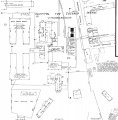Cherry Hospital
| Cherry Hospital | |
|---|---|
 | |
| Established | 1877 |
| Construction Began | 1878 |
| Opened | 1880 |
| Closed | 2016 (Old hospital) |
| Current Status | Active |
| Building Style | Cottage Plan |
| Location | Goldsboro, NC |
| Alternate Names |
|
History[edit]
In 1877, the North Carolina General Assembly appointed a committee to recommend the selection of a site for a facility for the black mentally ill which would serve the entire state. On April 11, 1878, one hundred seventy-one acres of land two miles west of Goldsboro were purchased. The site was described by Governor Z. B. Vance as ideal for a hospital building because of good elevation in a high state of cultivation and central location for the black population.
On August 1, 1880, the first patient was admitted to the then named "Asylum for Colored Insane". Since that time, there have been several name changes including: The Eastern North Carolina Insane Asylum, Eastern Hospital, and State Hospital at Goldsboro. The name was changed to Cherry Hospital in 1959 in honor of Governor Gregg Cherry.
The bed capacity for the hospital when established was seventy-six but over one hundred patients were crowded into the facility by Christmas of 1880. These patients were being cared for through a $16,000 appropriation. On March 5, 1881, the Easthern North Carolina Insane Asylum was incorporated and a board of nine directors appointed. The Board of Directors sought more appropriations for treatment of the black mentally ill. A separate building was established for treating tubercular patients. In addition, a building for the criminally insane was opened in 1924.
The early treatment program was mainly custodial; however, early reports indicated that thirty-four percent were "cured" and released within the first six months of hospitalization. Chapel facilities and chaplain services were not available until the early 1950's but selected patients were allowed to visit churches in Goldsboro under supervision of an attendant. An occupation therapist was employed in 1932 but therapy was mainly confined to the farm, laundry, kitchen and yard work. Today a wide range of occupational and recreational therapies are provided.
Tranquilizing medications were widely used by 1955 and helped revolutionize patient treatment. As a result of extensive use of psychotropic drugs, the rate of discharges began to increase and the length of hospitalization decreased. While discharges increased, the admission rate also increased significantly and the resident population remained virtually stable at approximately 3,000 patients between 1950 and 1965. The highest rate of occupancy was approximately 3,500 patients. During its first 100 years of service, Cherry Hospital served 91,045 patients.
The budget for the hospital has grown from $16,000 in 1880, to over $64 million for Fiscal Year 2001-2002. There are currently 1,243 positions providing a wide range of patient care and programs as well as administrative support.
For the first eighty-five years of its history, Cherry Hospital served the entire black population for the State of North Carolina. In 1965, the hospital joined other state hospitals in implementing the Civil Rights Act. Cherry began serving patients from the thirty-three counties in the Eastern Region in 1965 by providing services for all races. Black patients at Cherry were transferred to hospitals in their appropriate region while Cherry received white patients from other hospitals in other regions.
A major milestone was reached in 1973 when Cherry Hospital was accredited for the first time by the Joint Commission on Accreditation of Hospitals. There have been subsequent surveys by this accrediting agency with each survey resulting in continued accreditation.
As Cherry Hospital enters the Twenty-first Century, we are keenly aware that treatment of the mentally ill is not a static process. The dynamic process of effectively helping the mentally ill requires a diligent and dedicated search for appropriate modes of treatment. Cherry Hospital is totally committed to the search of excellence in serving the mentally ill as reflected in our mission statement--"The mission of Cherry Hospital is to provide quality inpatient psychiatric services for the Citizens of Eastern North Carolina."[1]
In late 2016 a new hospital facility opened to replace the original outdated hospital. The new hospital provides expanded services and additional capacity encompassed in one building. Amenities include a modern laboratory, dental and radiology departments and equipment, internal and external courtyards, a treatment mall (known as the "Hope and Wellness Center") decorated with flexible pictures hung magnetically, gymnasium and exercise room, library equipped with computers, cosmetology and barber shops, and anti-ligature doors/hinges/hooks and tempered glass.
Images[edit]
Main Image Gallery: Cherry Hospital
Museum Information[edit]
The Cherry Hospital Museum is located in the Special Services house on the hospital campus. The museum depicts the history of this psychiatric hospital opened in 1880 for the African American mentally ill. Written documents, photographs, a scrapbook, artifacts, and a PowerPoint presentation are available. Admission is free and open to the public from 8:00 a.m. to 5:00 p.m., Monday-Friday. Groups are welcome and tours may be scheduled in advance.
Contact the museum at 919-731-3417
Cemeteries[edit]
There are reportedly at least three burial areas on the campus of the hospital. It is estimated that there are well over 3000 people buried on the grounds. Only some 700 or so graves are marked with upright brass crosses bearing patient name and dates. There is no known extant listing of all those buried here. However, an extensive listing of all those thought to have been buried on the hospital grounds since about 1913 may be found on Find a Grave. Death certificates are not available online for those who died before about 1913. (source: Suzannah McCuen, MD)




